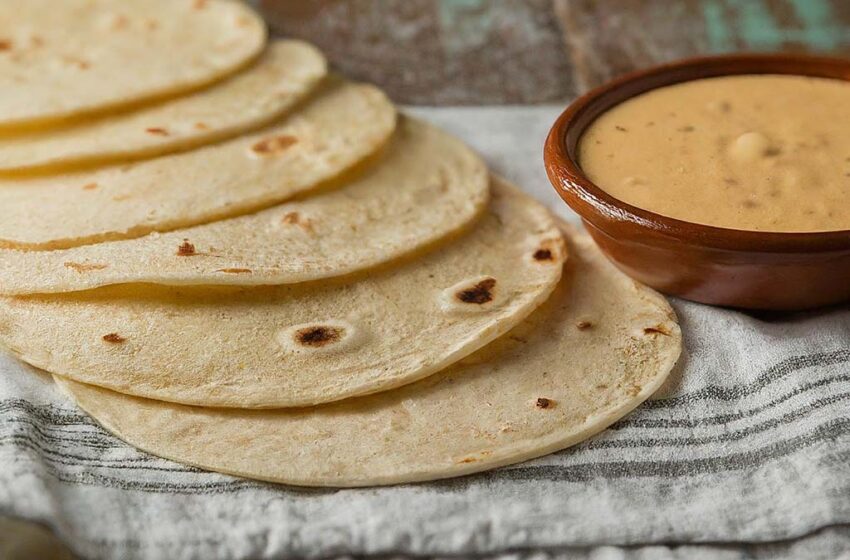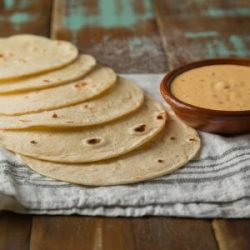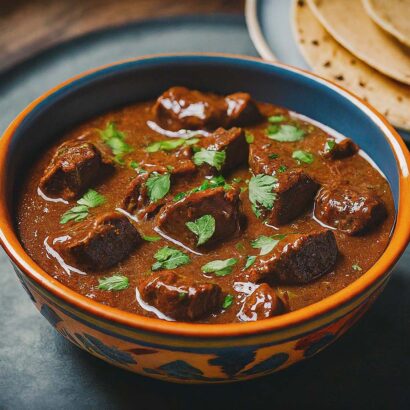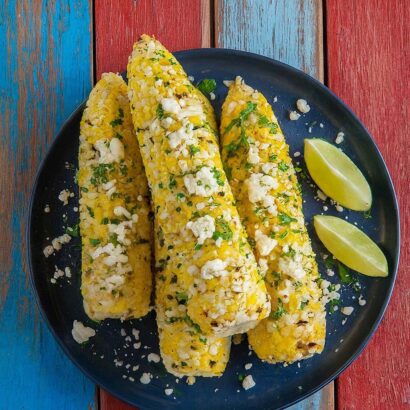Homemade flour tortillas have a rich history rooted in the culinary traditions of Mexico and the southwestern United States. Originating in the northern regions of Mexico, where wheat was more commonly grown than corn, flour tortillas became a staple due to their versatility and ease of preparation. They are an integral part of the food culture, often used in traditional dishes like burritos, quesadillas, and fajitas. The practice of making flour tortillas at home has been passed down through generations, preserving the authentic flavors and techniques that define this beloved food.
Making homemade flour tortillas is surprisingly simple and requires only a few basic ingredients: flour, water, salt, baking powder, and a fat source like lard or vegetable oil. The process involves mixing the ingredients to form a dough, dividing it into small balls, and rolling them out into thin circles before cooking on a hot griddle. This straightforward method allows even novice cooks to produce soft, pliable tortillas that far surpass store-bought versions in both taste and texture. The minimal ingredients and quick cooking time make homemade flour tortillas an accessible and rewarding project for anyone looking to explore traditional cooking methods.
Flour tortillas are incredibly versatile and pair well with a wide variety of foods. They are perfect for making classic dishes like tacos, burritos, and enchiladas, where they serve as a flavorful and sturdy wrap for various fillings. They can also be used as a base for tostadas or cut into wedges and fried to make crispy tortilla chips. Beyond Mexican cuisine, flour tortillas can be employed in fusion dishes or as a substitute for bread in wraps and sandwiches. Their mild flavor and soft texture complement everything from spicy meats and beans to fresh vegetables and cheeses, making them a beloved component of diverse culinary traditions around the world.
To start making these easy homemade flour tortillas, in a medium-sized bowl, whisk together the flour, baking powder, and salt.
If you are using lard, shortening, or butter, make sure it is soft and add it to your flour mixture. Use your hands or a pastry blender to work the fat into the flour until it disappears. Coating most of the flour with fat inhibits gluten formation, making the tortillas easier to roll out. If using vegetable oil, simply pour it in.
Pour in the hot water. Yes, hot (not scalding) water! Stir briskly with a fork or spatula to bring the dough together into a shaggy mass. I typically use a spatula, alternating between a cutting action to mix the dough and scooping around the edge to bring all the flour towards the center.
The amount of water you use has a noticeable effect on the final product. If you use too little the tortillas will be hard to roll out and they will end up thick and chewy. You want your dough to be tacky, with just a bit sticking to your hands, but not so wet that pieces stick to everything.
Turn the dough out onto a lightly floured counter and knead for a few minutes, just until the dough forms a nice solid ball. If the dough is too sticky, this is your chance to work in some flour.
Return the dough to the mixing bowl and cover with a cloth to let rest for at least 15 minutes.
Divide the dough into 16 pieces. Yes, 16 pieces! Most recipes will say only 8, but I when I used to do that I would end up with either a super large tortilla (that was a pain to roll out that thin), or one that is too thick and not soft nor fluffy. I usually toss the extra pieces back in the mixing bowl and keep covered. Just remove one a time.
Start preheating your cast iron skillet, or griddle. I find that a medium heat works best, it will vary based on your stove, what your cooking with, how fast you go, etc.
Prepare your work area by lightly dusting the counter surface and your rolling pin. Keep extra flour on-hand, you will need it as you work through all the dough.
Roll the dough into a ball with your hands, it should be roughly the size of a golf ball. I start by simply pressing the dough down with my hand till the dough it about 3″ in diameter. From there you can roll with your rolling pin. Take your time rolling a little bit, then take the dough and turn it 90° (and flip over if you want) and roll some more. Continue the process or rolling and turning until you reach about a 7″ tortilla. If it becomes too sticky, sprinkle some flour on both sides. Don’t be afraid to keep sprinkling with flour, it makes a world of difference being able to roll out the tortilla THIN. You will end up with a raw tortilla that seems too thin, but once you cook it, you’ll see.
In the image you can see where I made a mistake and pinched the dough. This illustrates why you should keep rolling just a little and turn. If you go too much in one direction you will end up with an odd shaped tortilla. It will taste just fine though!
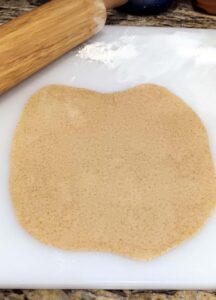
Cook the tortilla in your skillet for about 20 – 30 seconds on each side. You want to aim for golden brown spots. Having no spots is okay, having one or two small black spot is okay, but having a lot of black spots you probably overcooked it. I find that after flipping the second side doesn’t take quite a long. It can take a couple temperature adjustments while cooking the tortillas before getting it dialed in.
I typically use a fork and my hand to flip. If you have a large bubble form (small ones are okay), simply poke it a few times with your fork to deflate it, if you don’t then the tortilla won’t cook evenly and you will end up with a burnt spot on the peak.
While one tortilla is cooking, you should be rolling out the next one and have it ready to go. Once you get a rhythm going you’ll get through all the tortillas in no time!
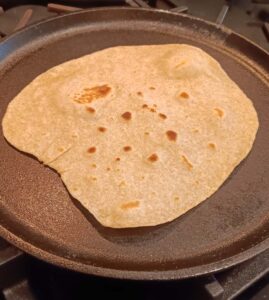
If you plan on serving the tortillas right away, simply keep them in between a clean cloth. You need to keep them covered while they are warm as this helps trap in some of the moisture keeping them soft.
If you are like me and only plan on using a couple, while storing the rest for another day. I will line a gallon sized plastic bag with paper towels. Then I simply pull the cooked tortilla off the skillet and put it straight into the bag (don’t seal it yet). After they cool for about 30 minutes you can simply pull out the paper towels and zip the bag closed. Yes, there will be a noticeable amount of moisture in the bag, but as it sits overnight it will get reabsorbed into the tortillas, keeping them nice and soft!
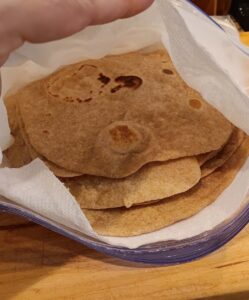
Easy Homemade Flour Tortillas
Equipment
- Mixing bowl
- Measuring cups and spoons
- Rolling pin
- Cast iron skillet
Ingredients
- 3 cups all-purpose flour (Can replace 1 cup with whole wheat)
- 2 tsp baking powder
- 1 cup hot water
- ⅓ cup vegetable oil (Can also use lard, shortening, or butter)
- 1 tsp salt
Instructions
- In a medium-sized bowl, whisk together the flour, baking powder, and salt.
- If you are using lard, shortening, or butter, make sure it is soft and add it to your flour mixture. Use your hands or a pastry blender to work the fat into the flour until it disappears. Coating most of the flour with fat inhibits gluten formation, making the tortillas easier to roll out.If using vegetable oil, simply pour it in.
- Pour in the hot water. Yes, hot (not scalding) water!Stir briskly with a fork or spatula to bring the dough together into a shaggy mass. I typically use a spatula, alternating between a cutting action to mix the dough and scooping around the edge to bring all the flour towards the center.The amount of water you use has a noticeable effect on the final product. If you use too little the tortillas will be hard to roll out and they will end up thick and chewy. You want your dough to be tacky, with just a bit sticking to your hands, but not so wet that pieces stick to everything.
- Turn the dough out onto a lightly floured counter and knead for a few minutes, just until the dough forms a nice solid ball. If the dough is too sticky, this is your chance to work in some flour.
- Return the dough to the mixing bowl and cover with a cloth to let rest for at least 15 minutes.
- Divide the dough into 16 pieces. Yes, 16 pieces! Most recipes will say only 8, but I when I used to do that I would end up with either a super large tortilla (that was a pain to roll out that thin), or one that is too thick and not soft nor fluffy. I usually toss the extra pieces back in the mixing bowl and keep covered. Just remove one a time.
- Start preheating your cast iron skillet, or griddle. I find that a medium heat works best, it will vary based on your stove, what your cooking with, how fast you go, etc.Prep your work area by lightly dusting the counter surface and your rolling pin. Keep extra flour on-hand, you will need it as you work through all the dough.
- Roll the dough into a ball with your hands, it should be roughly the size of a golf ball. I start by simply pressing the dough down with my hand till the dough it about 3" in diameter. From there you can roll with your rolling pin. Take your time rolling a little bit, then take the dough and turn it 90° (and flip over if you want) and roll some more. Continue the process or rolling and turning until you reach about a 7" tortilla. If it becomes too sticky, sprinkle some flour on both sides. Don't be afraid to keep sprinkling with flour, it makes a world of difference being able to roll out the tortilla THIN. You will end up with a raw tortilla that seems too thin, but once you cook it, you'll see.In the image you can see where I made a mistake and pinched the dough. This illustrates why you should keep rolling just a little and turn. If you go too much in one direction you will end up with an odd shaped tortilla. It will taste just fine though!
- Cook the tortilla in your skillet for about 20 – 30 seconds on each side. You want to aim for golden brown spots. Having no spots is okay, having one or two small black spot is okay, but having a lot of black spots you probably overcooked it. I find that after flipping the second side doesn't take quite a long. It can take a couple temperature adjustments while cooking the tortillas before getting it dialed in. I typically use a fork and my hand to flip. If you have a large bubble form (small ones are okay), simply poke it a few times with your fork to deflate it, if you don't then the tortilla won't cook evenly and you will end up with a burnt spot on the peak.While one tortilla is cooking, you should be rolling out the next one and have it ready to go. Once you get a rhythm going you'll get through all the tortillas in no time!
- If you plan on serving the tortillas right away, simply keep them in between a clean cloth. You need to keep them covered while they are warm as this helps trap in some of the moisture keeping them soft.If you are like me and only plan on using a couple, while storing the rest for another day. I will line a gallon sized plastic bag with paper towels. Then I simply pull the cooked tortilla off the skillet and put it straight into the bag (don't seal it yet). After they cool for about 30 minutes you can simply pull out the paper towels and zip the bag closed. Yes, there will be a noticeable amount of moisture in the bag, but as it sits overnight it will get reabsorbed into the tortillas, keeping them nice and soft!
Notes
- Not using enough water, and my dough was too firm and too hard to work.
- Not dividing the dough up into small enough portions.
- Not re-flouring the tortilla while rolling, so it would stick to the counter and not stretch out freely.

